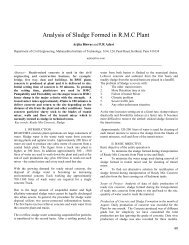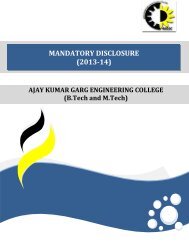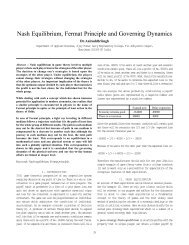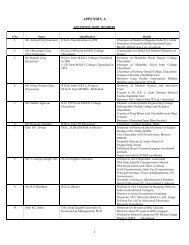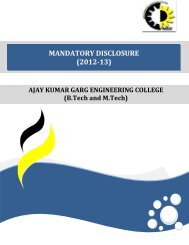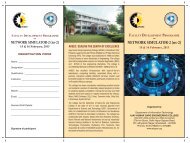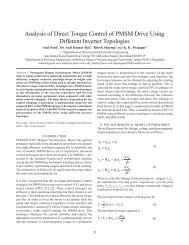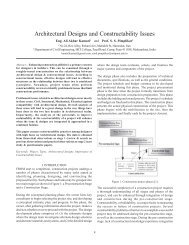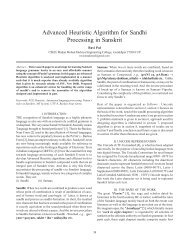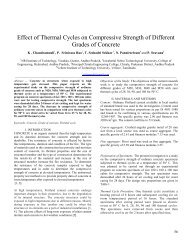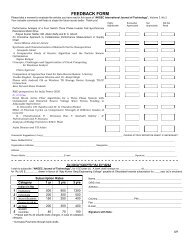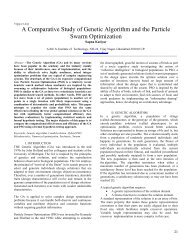Linear Chirp Signal and Exponential Sweep Signal Suppression ...
Linear Chirp Signal and Exponential Sweep Signal Suppression ...
Linear Chirp Signal and Exponential Sweep Signal Suppression ...
Create successful ePaper yourself
Turn your PDF publications into a flip-book with our unique Google optimized e-Paper software.
SIGNAL SUPPRESSION USING VOLTERRA FILTERSWorking of Volterra filter as Broadb<strong>and</strong> Interference ExciserIn Volterra filter, the received sequence of length ‘N’ is exp<strong>and</strong>edby Volterra series into a longer sequence of length ‘M’ suchthat M>N. It is processed with an M tap filter [5].measurement helps us to see if our system model is indeedminimizing the error <strong>and</strong> it is sometimes called the learningcurve of the algorithm [8].Most workers have used the second <strong>and</strong> the third orderVolterra filters that gives fair level of computationalcomplexity. As for the sake of simplicity we are usingsecond order Volterra filter [9].Adaptive second order Volterra filterVolterra series expansion of second order, is described bythe truncated version of equation (1).Figure 1. A Block Diagram of Adaptive Volterra Filter.As shown in Figure 1, the system consists of twochannels. The first channel is used to transmit the desiredinput signal s(n). However due to a noisy environment, thesignal is contaminated <strong>and</strong> the channel produces a signalwith the interference that is broadb<strong>and</strong> in our case, sod(n) = s(n)+n(n). The second channel is left vacant <strong>and</strong> noinput signal is given to it so it only captures interferencex(n), which is fed to the Volterra filter. Note that thecorrupting interference n(n) in the first channel isuncorrelated to the desired signal d(n), so that separationbetween them is possible. The interference signal x(n) fromthe second channel is correlated to the corruptinginterference signal n(n) in the first channel, since bothcome from the same noise source. Similarly, the interferencesignal x(n) is not correlated to the desired speech signald(n). We assume that the corrupting interference in the firstchannel is linear filtered version of the second-channelinterference, since it has a different physical path from thesecond-channel interference, <strong>and</strong> the interference source istime-varying, so that we can estimate the corrupting signaln(n) using an adaptive Volterra filter.The Volterra filter is actually a digital filter with adjustablecoefficients <strong>and</strong> the LMS or RLS algorithm modifies thevalues of the coefficients for filtering each sample. TheVolterra filter then produces an estimate of interferencey(n), which will be subtracted from the corrupted signald(n) = s(n)+n(n). When the noise estimate y(n) equals orapproximates the noise n(n) in the corrupted signal, that is,y(n) ≈ n(n), the error signal e(n) = s(n)+n(n)-y(n) ≈ s(n) willapproximate the clean input signal s(n). Hence, theinterference is suppressed. Aim of the filter is to producey(n) very close to d(n) or minimize e(n) such that theinterference is suppressed as it reaches to the receiver [7].According to the above idea the following performancemeasure used in Volterra filter is defined by Mean SquareError (MSE). The MSE is a measure of how the algorithmconverges to the true value in a mean square sense & thiswhere w 0i(l 1,l 2) for i= 0, 1, . . . ,N, are the coefficients ofthe nonlinear filter model based on the second-orderVolterra series expansion, <strong>and</strong> Y(n) represents the adaptivefilter output signal [6]. Now, the input signal X(n) isinterpreted in the following wayX(n) = [ x(n) x(n-1) — x(n-N) x 2 (n) x(n)x(n-1)— x(n)x(n-N) x(n-N)x(n-N+1) x 2 (n-N)]The filter coefficients are interpreted in the following wayW(n)= [w o(n) w 1(n) — w N(n) w 0,0(n) w 0,1(n) — w 0,N(n)— w N,N-1(n) w N,N(n)]So, the output, Y(n) is as follows:Y(n) = W T (n)X(n)Volterra kernels estimation by the LMS (least meansquare) adaptive algorithm:The well-known LMS algorithm is a sample basedalgorithm, which does not require collection of data <strong>and</strong>does not involve matrix inversion.Though the LMS algorithm has its weakness such as itsdependence on signal statistics, which can lead to lowspeed or residual errors, it is very simple to implement <strong>and</strong>well behaved compared to the faster recursive algorithms.The Volterra filter input <strong>and</strong> output can be compactlyrewritten asY(n) = W T (n)X(n)where, X(n) <strong>and</strong> W(n) are N most recent inputs <strong>and</strong> theirnonlinear combinations into one exp<strong>and</strong>ed input vector <strong>and</strong>exp<strong>and</strong>ed filter coefficients vector respectively.The error signal e(n) is formed by subtracting Y(n) fromthe noisy response d(n)e(n) = d(n)-Y(n)19
AKGEC INTERNATIONAL JOURNAL OF TECHNOLOGY, Vol. 4, No. 1For the LMS algorithm we have to minimize the errorE[e 2 (n)] = E[d(n)-Y(n)]The well known update equation for a first order filter is• Much more easily parallelizedThe algorithm works in the following manner.As we already know that our objective is to minimize thecost function:H(n+1) = H(n)+ ì e(n) X(n)where step-size(ì),controls the convergence behavior of thealgorithm: the larger the value of ì the faster the algorithmconverges, but this would also cause a greatermisadjustment (i.e., larger residual error signal ) in steadystate.For the algorithm to be stable, ‘ the step-size must bechosen from 0 to 2.Volterra kernels estimation by the RLS (recursive leastsquare) adaptive algorithm:This algorithm tries to minimise the cost function:where, ‘ë’ is a forgetting factor resulting in anexponentially weighted mean square error.e(n) = d(n)-X T (n)H(n-1)k(n) = C -1 (n-1)X(n-1)/ë+ X T (n) C -1 (n-1) X(n)W(n) = W(n-1)k(n)e(n)where, C -1 is the inverse of the exponentially weightedleast-squares auto-correlation matrix of the input vector, P isexponentially weighted least-squares cross-correlationvector, W is the vector of coefficients, X is the inputvector (containing the output of individual Volterra terms),<strong>and</strong> k is the gain vector. The equations for RLS areidentical to linear RLS algorithm, with the big differencebeing the composition of the input vector <strong>and</strong> weightingvector.Volterra kernels estimation by the QR-RLS algorithmadaptive algorithm:The QR decomposition is a superb tool offering increasedrobustness, reduced complexity [11].This is a transformation to find Q matrix (as given in thebelow algorithm). It is most useful because:• Don’t have to build a new matrix but justmanipulating original matrix solves the problem sothe complexity involved is very less.(2)where, î (n) is a scalar denoting the cost function, e(i) isthe error at time i for 1
SIGNAL SUPPRESSION USING VOLTERRA FILTERSPerformance analysis of the DS-SS system in the presence of<strong>Linear</strong> <strong>Chirp</strong> <strong>Signal</strong> over AWGN channel using Volterra filterwith various algorithmsFigure 6 shows the BER as SNR changes where interferingsignal power is held constant at 10 dB, while noise power isvaried from -4 dB to 5 dB relative to SS signal.Figure 8. Performance analysis of the DS-SS system in thepresence of <strong>Exponential</strong> <strong>Chirp</strong> <strong>Signal</strong> over AWGN channel usingVolterra filter with various algorithmsFigure 6. Comparison of algorithms in <strong>Linear</strong> <strong>Chirp</strong> <strong>Signal</strong>Interference suppression.This simulation is done over 1000 input bits with spreadingcode length of 7 <strong>and</strong> averaged over 100 times. The value of ë istaken to be 0.98 for RLS, QR-RLS <strong>and</strong> Fast RLS algorithm.Further the value for å is taken to be 0.5 in case of Fast RLSalgorithm.• The simulated exponential chirp signal of power 10 dB,<strong>and</strong> power spectral density of simulated broadb<strong>and</strong>interference.Figure 9. Comparison of RLS, QR-RLS algorithms in <strong>Exponential</strong><strong>Chirp</strong> <strong>Signal</strong> suppression over AWGN Channel.Figure 10. Comparison of FRLS algorithms in <strong>Exponential</strong><strong>Chirp</strong> <strong>Signal</strong> suppression over AWGN Channel.Figure 9 <strong>and</strong> Figure 10 show the BER as SNR changes whereinterfering signal power is held constant at 10 dB, while noisepower is varied from -4 dB to 5 dB relative to SS signal.Figure 7. Simulated <strong>Exponential</strong> <strong>Chirp</strong> <strong>Signal</strong>This simulation result is again obtained for 1000 input bitswith spreading code length of 7 over AWGN channel. Thevalue of ë is taken to be 0.98 for RLS, QR-RLS <strong>and</strong> Fast RLSalgorithm. Further the value for å is taken to be 0.5 in case ofFast RLS algorithm. We can conclude from figure 9 that RLS or23
AKGEC INTERNATIONAL JOURNAL OF TECHNOLOGY, Vol. 4, No. 1QR-RLS Volterra filter performs well <strong>and</strong> achieve goodperformance. As we decrease the AWGN power, RLS VolterraBER performance improves whereas QR-RLS provideapproximately constant BER performance irrespective of theSNR. We can also conclude for Figure 10 that Fast- RLS Volterrafilter performs well under low SNR range. As we increase theSNR, the performance of system degrades over AWGN channel.IV. CONCLUSIONIn this paper, most significant work is to study the VolterraFilters <strong>and</strong> second most significant work is, through Matlabsimulation it has been shown that Fast-RLS Volterra filter basedDSSS receiver is very efficient in suppressing the <strong>Linear</strong> chirpsignal <strong>and</strong> QR-RLS Volterra Filter based DSSS receiver is veryefficient in suppressing the <strong>Exponential</strong> sweep signal.Results expressed in BER, show that Volterra filter is successfulin the broadb<strong>and</strong> interference suppression process. It enablesthe DSSS signal reception even in the presence of the strongbroadb<strong>and</strong> interference. Apart from broadb<strong>and</strong> interferencesuppression, Volterra filters have recently gained significantinterest in many advanced applications, including acousticecho cancellation, Channel equalization, biological systemmodeling <strong>and</strong> image processing.V. REFERENCES[1] J.D. Laster <strong>and</strong> J.H Reed, “Interference Rejection in DigitalWireless Communications”, IEEE Magazine, Vol. 14, No.3,pp.37-62, May 1997.[2] R Tanner, D.G.M. Cruickshank: “Volterra Filter Structure forDS-CDMA”, Vehicular Technology Conference, VTC’ 96,Atlanta, 1996.[3] C.E. Davila, A.J. Welch, H.G. Ryl<strong>and</strong>er,III: “A Second- OrderAdaptive Volterra Filter with Rapid Convergence”, IEEE Trans.on ASSP, Vol.35, No. 6, Sep.1987, pp. 1259-1263.[4] R..Vijayan <strong>and</strong> H.V. Poor, “Nonlinear Techniques forInterference <strong>Suppression</strong> in Spread-Spectrum Systems”, IEEETrans. on Comm, Vol. 38, No. 7, July 1990, pp. 69-96.[5] D.R. Morgan: Review of the book-Adaptive <strong>Signal</strong> Processingby Widrow <strong>and</strong> Stearns. IEEE Trans., Acoustics, Speech, <strong>and</strong><strong>Signal</strong> Processing, pp. 1017-1018.[6] R.D. Nowak, “Penalised least squares estimation of Volterrafilters & higher order statistics”, IEEE Trans, Image <strong>Signal</strong>Proc., Vol. 147, No. 2, January 1997, pp. 1-23.[7] D. Kocur <strong>and</strong> R. Zetik, “Volterra Filter Application in DSSSReceiver for Wideb<strong>and</strong> <strong>and</strong> Narrowb<strong>and</strong> Interference<strong>Suppression</strong>”, Proc. IEEE 7th International Symposium onSpread Spectrum Techniques & Applications, pp. 648-651,Czech Republic, 2002.[8] D. Zoran, D. Miroslav <strong>and</strong> Z. Vesna, “Broadb<strong>and</strong> Interference<strong>Suppression</strong> in DSSS Receiver by Volterra Filter,” IEEE 5thInternational Symposium on Spread Spectrum Techniques <strong>and</strong>Applications, pp. 127-129, 1998.[9] S. Agarwal, R.C Jain <strong>and</strong> D.B Ojha, “Broadb<strong>and</strong> Interference<strong>Suppression</strong> using Volterra filters”, Journal of Global Researchin Computer Science, Vol. 3, No. 11, November 2012, pp. 27-31.[10] J.Lee <strong>and</strong> V. J. Mathews, “A Fast Recursive Least SquaresAdaptive Second-Order Volterra Filter <strong>and</strong> Its PerformanceAnalvsis”, IEEE Trans on <strong>Signal</strong> Proc., Vol. 41, No. 3, March1993, pp. 1087-1102.[11] M.A Syed <strong>and</strong> V.J. Mathews, “QR-Decomposition basedalgorithms for adaptive Volterra filtering”, IEEE Trans on <strong>Signal</strong>Proc, Vol. 40, No. 6, June 1996, pp 1-11.[12] Stephen Poythress Boyd, “Volterra Series: EngineeringFundamentals”, PhD Dissertation, A.B. (Harvard University),1980.Sheena Agarwal (b. Jan 1990) obtained B.Tech degree in Electronics <strong>and</strong> CommunicationEnineering from ABES College, Ghaziabad in2011.Completed M. Tech in Electronics <strong>and</strong>Communication engineering from JaypeeInstitute of Information Technology, Noida(a deemed university) in 2013.Based on her M. Tech work, Lambert AcademicPublishing House of Germany published an e-Book entitled, ‘Applicationof Volterra Filters in Broadb<strong>and</strong> Interference <strong>Suppression</strong> inCommunication Systems’ in 2013.She has 5 more technical papers to her credit. Won the Best paperpresentation Award at the Advanced Communication TechnologiesConference held at BBDIT, Ghaziabad in March 2013.She is trained in vocal classical music <strong>and</strong> passed ‘Visharad’ fromBhatkh<strong>and</strong>e Sangeet Vidyapeeth, Lucknow in 2012. Daily practicesArt-of-Living meditation.Dr. R.C. Jain is Professor <strong>and</strong> Head, ECEDepartment, Jaypee Institute of InformationTechnology, Noida, since July, 2007 till date.He obtained Ph.D, in Electrical Engineeringfrom the University of Alberta, Canada in1988 <strong>and</strong> M. Eng. in Electrical Engineeringfrom the same, University in 1985. Earlier hedid M.E. in Microwave Engineering from theUniversity of Roorkee in 1978.His areas of interest include Wireless Communication Systems.He has been awarded:1. Canadian Commonwealth Scholarship <strong>and</strong> Fellowship, 1983.2. CDIL Award of the Institution of Electronics <strong>and</strong>Telecommunication Engineers (IETE), India in the year 1994for the best paper in Industrial Applications category.3. K S Krishnan Memorial Award of the IETE, India in the year1999 for a paper published in the IETE Journal of Research.4. IETE-Students’ Journal Award, 2006 for a paper published inIETE Journal of Education.24



